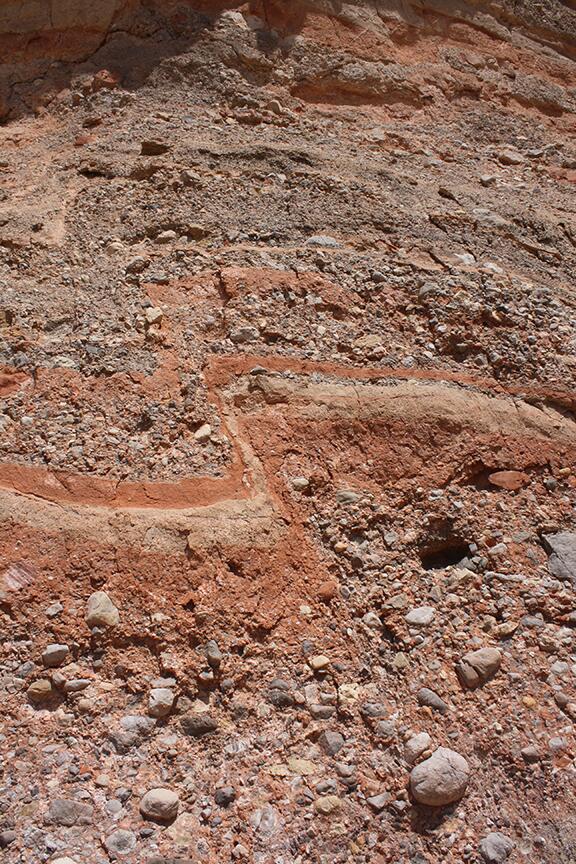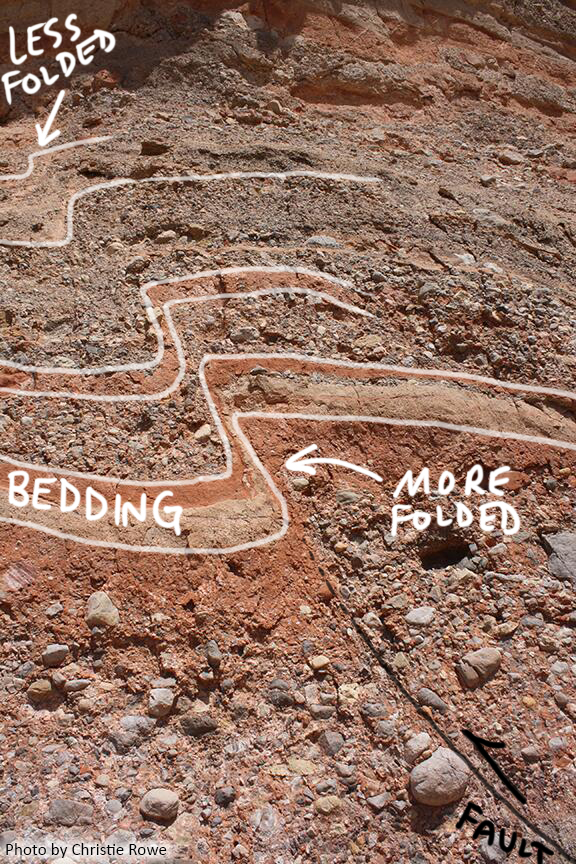Another guest Friday fold – again, from the structural geologist Christie Rowe at McGill University in Montreal:

Christie describes this as: growth faulting in beautiful fluvial sediments… Accordingly, I have squinted and annotated it a bit:

Happy Friday!

I’m less familiar with the term in your title “fault-growth folding” per se. But it’s certainly not what is commonly called a growth fault (what Christie termed it).
This seems (as you have annotated) a reverse fault, and not what I’d call a growth fault which is a normal fault where more sediment accumulates on the hanging wall as it moves down and creates accommodation space.
If your interpretation of the “less folded” section at the top is correct — not clear to me that it is – I would have looked at this and said it’s structural accommodation in the sediments of a blind thrust. Is that what “fault-growth folding” means? I googled it and only found this page!
It’s a beauty, by the way. I’ve never had much opportunity for field work around reverse faulting in unconsolidated sediments, if these are indeed unconsolidated. And of course, unlike with normal growth faulting, reverse faulting active during deposition should be creating accommodation space on the footwall instead of the hanging wall, as your “less folded” interpretation would indicate.
Hi Paul and Callan
I should have perhaps said “propagation” instead of “growth” – indeed as you described, I was referring to the growth of the fault, not the growth of the basin as is more commonly used in extensional settings. (here’s a similar case: http://geode.colorado.edu/~structure/research/faultrelatedfolds.htm)
Callan your sketch is correct. If you wanted to add another layer of complexity, the fault surface is actually not continuous but it’s a left-side-up set of en eschelon cracks
If this represents multiple displacement events (earthquakes) as I’d interpret to be meant by growth faulting, then I’d want to verify that the vertical displacement of the beds away from the fault reflect the same change in displacement as seen adjacent to the fault. Upward termination of faults within gravelly unconsolidated sediments is (frustratingly for paleoseismologists like myself) very common. I don’t think I’d be stretching to say that this is particularly common for thrust/reverse fault earthquakes. Without being able to see the full exposure, I’d just call this a blind reverse fault. Could also think of it as a fault-propagation fold, right?
Whatever you want to call it, this is exceptionally awesome. Gorgeous shot of a jaw-dropping structure. What’s the location?
Really nice. I suppose penecontempraneous deformation can create such structures due to compaction and subsequent dewatering.
Really nice. I suppose penecontemporaneous deformation can create such structures due to compaction and subsequent dewatering.
Hey great discussion on this photo.
The fold is one of many locally (sent Callan another photo for context, maybe he’ll add it to this post). The folds and the faults in the core of the folds show both reverse and normal apparent motion – I think the overall tectonic context during deposition of these gravels was oblique transtensional, and the local reverse motion is associated with strike-slip flower structures. These are Miocene fluvial seds in the Las Vegas Valley Shear Zone, just west of Lake Mead. The distributed shear shows that the sediments were not strongly consolidated during faulting (faults cutting cobbles are rare but I found a few). Callan’s annotation shows the general orientation of the fault – but in detail, the fault is actually composed of stepping, more steeply dipping en eschelon faults. I think this is consistent with very shallow deformation with only weak confinement.
Sean – The displacement on these faults was certainly episodic – these episodes might be earthquakes but they may also be creep or compaction events. The accepted criteria for identifying an earthquake event in a rock seems quite different than the criteria used by the surface process folks. Would be interesting to compare.
This reminds me of Growth Faults (Extension). I know that displacement of Growth Faults is increasing with depth. And this fault in the photo shows the same behavior (since I’m thinking that more or less folding is related to rate of slip). Is this related to fault propagation? I mean is this fault reaching surface or getting lost? thanks in advance
I think the fault is slipping below the surface and growing upward, but not fast enough to keep up with deposition